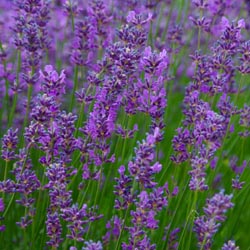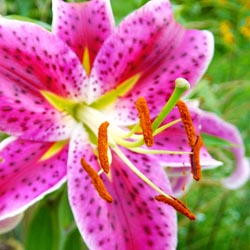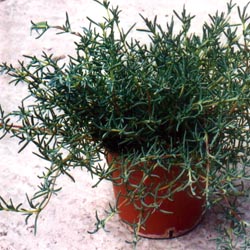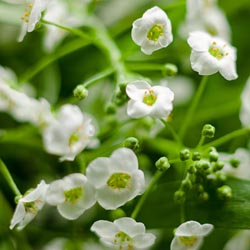Plants don’t have to be hidden away at night, and there are many different plants that can be dramatic in the evening or well after dark. While the most obvious way to enhance the darkness is to use flowers that are light or white in color, you can also add plants with fragrant flowers or foliage. And, typically, evening bloomers often have a strong fragrance to attract night flying moth pollinators. Popular plants that thrive in evening gardens include…
Annuals and Tropicals
- Allysum (Lobularia maritime): This fragrant, sweet-smelling annual grows easily to form a mat of small, white, light pink or purple flowers and grows 2-6″. Plant or sow seeds in full sun.
- Heliotrope (Heliotropium arborescens): Look for the white-flowered form for the best evening visibility. It is not as showy as the popular dark violet version, but it’s more fragrant and will be more visible in darker lighting.
- Licorice Plant (Helichrysum petiolare): Small, round, woolly leaves in silvery grey drape well in hanging baskets and can be very showy at night.
- Jasmine (Jasmine officinale): This white-flowered jasmine is a vigorous twining shrub producing very fragrant flowers, attracting moths and glowing under moonlight.
- Moonflower (lpomoea alba): Easy to grow, this annual has large, white, pink or purple fragrant blooms that open in early evening and last all night. Heart-shaped leaves make this a great vine to cover a trellis or fence. This fast-grower loves full sun.
- Stock (Matthiola incana): Many kinds bear fragrant flowers that can add a delicious sensory experience to an evening garden.
- Tobacco Flower (Nicotiana sylvestris): Long, tubular white flowers are intensely fragrant and dramatically visible even in near-darkness.
Perennials
- Hosta (Hosta ‘Sum and Substance’): The bright, glossy chartreuse/gold large leaves (10″ across) of this hosta form a mound of brightness in the moonlight.
- Lamium (Lamium maculatum selections): An excellent ground cover for shade, this plant has leaves of silvery white and green with white, pink or purple blooms.
- Lavender (Lavandula): Fragrant English lavender (L. angustifolia), French lavender (L. dentata), ‘Provence’ and similar types (L. x intermedia) are the best bets for evening beauty.
- Evening Primrose (Oenothera fruticosa): Night-flying insects are attracted to the delicate fragrance of this pretty flower. Remaining closed during the day, its petals uncurl at dusk. These drought-tolerant plants are ideal in full sun.
- Pinks (Dianthus): Many hybrids have lost their delightful clove scent, but others are reliably fragrant. These include cheddar pinks (D. gratianopolitanus); cottage pinks (D. plumarius) and maiden pinks (D. deltoides).
- Verbena (Verbena bonariensis): Tall, erect stems with clusters of small, purple flowers attract moths at night as well as bees and butterflies during the day. Grow in a sunny spot in moist, well-drained soil.
Bulbs
- Lilies: Madonna lily (L. candidum), ‘Stargazer’, ‘Casablanca’ and other Oriental hybrids are extremely fragrant and beautiful, even in darker conditions.
- Tuberose (Polianthes tuberosa): This bulb, treated as an annual, produces exotic, sweet-smelling white flowers.
Shrubs/Vines
- Butterfly Bush (Buddleja davidii ‘White Profusion’): This luminous plant has fragrant flowers that make it irresistible to moths. Also try the deep purple ‘Black Knight’ for a dramatic contrast. Plant in a sunny, well-drained location.
- Daphne (Daphne burkwoodii): ‘Carol Mackie’ has variegated foliage with star-shaped, richly fragrant, pale pink flowers that can glow in moonlight.
- Japanese Honeysuckle (Lonicera japonica): Either evergreen or deciduous varieties can be a suitable choice for evening interest.
- Mock Orange (Philadelphus): Most kinds are fragrant, especially sweet mock orange (P. coronarius).
- Roses (Rosa): Many old roses are fragrant, including the damasks, Bourbons, hybrid perpetuals, Chinas and rugosas, as are many David Austin shrub roses. Choose varieties with white or pale blooms for more evening or nighttime glamour.
- Summersweet (Clethra alnifolia): This handsome, well-foliaged shrub has a summertime display of fragrant, pinkish-white flower spikes lasting for up to six weeks. It is well-suited for use near water and a good bee plant.
- Viburnum (Viburnum species): Three selections are especially fragrant and ideal for evening flair: ‘Burkwood Viburnum’ – An upright 8-10’, multi-stemmed shrub that produces a white flower. ‘Korenspice Viburnum’ – With a mature height of 5′ to 8′, the Korenspice has pink to reddish buds that open to fragrant, white flowers. ‘Mohawk Viburnum’ – A cross between Burkwood and Korenspice, the Mohawk displays dark red buds which open to white with red blotched reverse flowers. The flowers have a strong clove fragrance to them.
Herbs
- Lemon Verbena (Aloysia triphylla): With an oh-so-lemony delightful fragrance, lemon verbena has fragrant, narrow leaves and small white flowers. Leaves are strongest in scent and flavor while the shrub is in bloom, but can be harvested at any time. Plant in a moist sunny location. Unlike many herbs, lemon verbena retains its scent for years when dried.
- Rosemary (Rosmarinus officinalis). Rosemary’s fragrant flavor is spicy, warm and pungent, reminiscent of pine, balsam and ocean air. There are so many uses for rosemary that no garden should be without this herb. Along a path, rosemary releases its fresh, clean scent when brushed against at any time of day or night. Rosemary can take the heat, and does well against a brick or stone wall or in a pot on a sunny patio or terrace.
- Scented Geraniums (Pelargonium): Of the many varieties, those with scents of rose, lemon and peppermint are the most fragrant.
- Pineapple Sage (Salvia elegans): This 3’ evergreen shrub has bright scarlet flowers in late summer and fall.
Adding plants specifically for evening enjoyment can enhance your garden for many hours, and with so many nighttime beauties to choose from, no garden should be without some after-dark drama.







